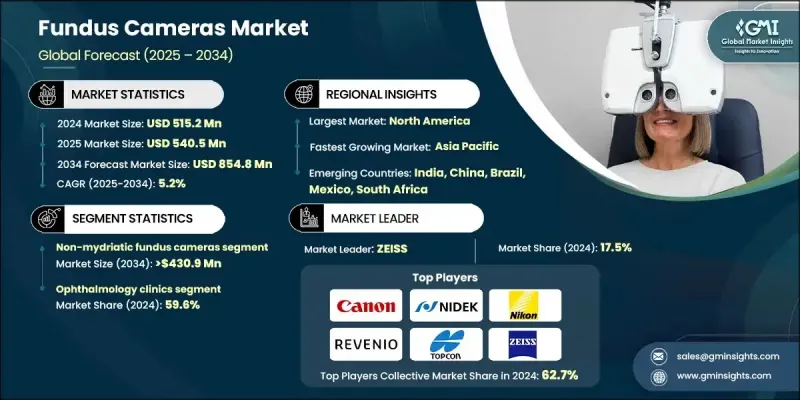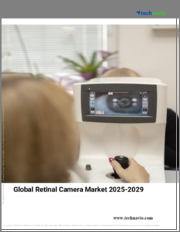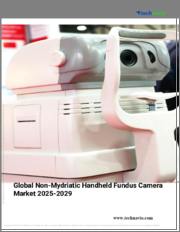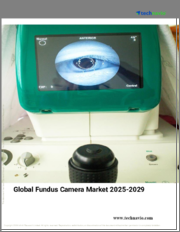
|
시장보고서
상품코드
1833674
안저 카메라 시장 기회, 성장 촉진요인, 산업 동향 분석, 예측(2025-2034년)Fundus Cameras Market Opportunity, Growth Drivers, Industry Trend Analysis, and Forecast 2025 - 2034 |
||||||
세계 안저 카메라 시장은 2024년에는 5억 1,520만 달러로 평가되었으며, CAGR 5.2%로 성장하여 2034년에는 8억 5,480만 달러에 달할 것으로 예측됩니다.

이 시장은 눈 관련 질환의 증가, 노인 인구의 증가, 영상 기술의 급속한 발전, 정부 및 의료기관의 시력 관리 강화 노력 증가로 인해 안정적인 성장세를 보이고 있습니다. 만성 안질환의 조기 진단 및 관리에 대한 수요가 증가함에 따라 의료 현장에서 첨단 망막 영상 처리 도구의 채택이 증가하고 있습니다. 원격의료 서비스로의 전환도 안과 의료 접근성 확대, 특히 의료 서비스가 부족한 지역의 안과 의료 접근성 확대에 중요한 역할을 하고 있습니다. 디지털 기술과 통합된 안저 카메라는 의료진이 원격 검진을 쉽게 시행할 수 있도록 하여 증상을 조기에 발견하고 대면 진료의 필요성을 줄여주고 있습니다. 컴팩트하고 사용하기 쉬운 인터페이스를 포함한 제품 설계의 지속적인 혁신으로 임상 워크플로우가 강화되고 효율성이 향상되었습니다. 또한, 광간섭단층촬영과 안저 영상을 하나의 장비에 통합함으로써 안과 의사의 진단 및 치료 방법이 크게 변화하고 있으며, 고해상도의 종합적인 망막 평가로 시간과 자원을 모두 절약할 수 있습니다.
| 시장 범위 | |
|---|---|
| 시작 연도 | 2024년 |
| 예측 연도 | 2025-2034 |
| 시장 규모 | 5억 1,520만 달러 |
| 예측 금액 | 8억 5,480만 달러 |
| CAGR | 5.2% |
무산동 안저 카메라 부문은 2024년 52.8%의 점유율을 차지했으며, 동공 확장 없이 빠르고 효율적인 촬영이 가능하다는 점이 그 요인으로 꼽힙니다. 이 카메라는 일차 진료 현장과 원격 안과 프로그램에 널리 보급되어 있으며, 높은 처리량의 안과 질환 검진에 이상적입니다. 사용 편의성과 환자 편의성은 임상 환경과 원격 환경 모두에서 컴플라이언스 및 접근성을 향상시키는 데 도움이 됩니다. 이 시스템은 기존의 확장 과정으로 인한 불편함과 지연을 없애고, 1차 검진이나 정기적인 안과 검진에 적합합니다.
안과 클리닉 분야는 2024년 59.6%의 점유율을 차지했으며, 2034년에는 5억 1,290만 달러에 달할 것으로 예상됩니다. 황반변성, 당뇨망막병증, 녹내장 등 안과 질환의 진단과 지속적인 치료의 주요 센터 역할을 하고 있습니다. 이러한 만성질환의 발병률이 전 세계적으로 지속적으로 증가함에 따라, 진료소에서는 보다 신속하고 정확한 치료를 지원하는 첨단 진단 솔루션의 도입이 진행되고 있습니다. 대부분 안저사진과 OCT 기술을 결합한 하이브리드 이미징 시스템을 채택하여 한 번의 검사로 종합적인 평가를 할 수 있도록 하고 있습니다.
2024년 북미 안저 카메라 점유율 41.6%입니다. 이 지역은 강력한 의료 인프라, 안과 진단 검사에 대한 명확한 상환 제도, 예방 의료에 대한 정부의 적극적인 참여 등의 혜택을 누리고 있습니다. 보험 적용은 병원, 진료소, 전문센터에서의 안저카메라 보급에 큰 힘이 되고 있습니다. 북미는 또한 첨단 안과 기술, 특히 영상 진단을 간소화하고 진단 정확도를 높이는 AI 지원 시스템 및 하이브리드 시스템 채택을 선도하고 있습니다.
세계 안저 카메라 시장의 주요 제조업체 및 공급업체로는 ZEISS, Nikon(Optos), NIDEK, TOPCON, Canon, Samsung, Visionix, epipole, Forus Health, Huvitz, Kowa, OPTOMED, Remidio, REVENIO, Volk Optical 등이 있습니다. 안저 카메라 시장의 주요 기업들은 경쟁력을 높이기 위해 지속적인 제품 개발, 디지털 플랫폼과의 스마트한 통합, 세계 진출에 주력하고 있습니다. 많은 기업들이 진화하는 임상 수요에 대응하기 위해 인공지능, 클라우드 기반 스토리지, 원격의료와의 호환성을 갖춘 디바이스를 강화하고 있습니다. 의료 서비스 제공자, NGO, 정부 프로그램과의 파트너십을 통해 기업이 신흥 시장에 진출하고 원격지에서의 검진 접근성을 개선할 수 있도록 돕고 있습니다.
목차
제1장 조사 방법과 범위
제2장 주요 요약
제3장 업계 인사이트
- 생태계 분석
- 업계에 대한 영향요인
- 성장 촉진요인
- 안질환 이환율 증가
- 유리한 상환 시나리오
- 기술적 진보
- 질병 조기 발견과 스크리닝 수요 증가
- 업계의 잠재적 리스크와 과제
- 안저 카메라의 고비용
- 신흥 경제 국가의 안과의 부족
- 시장 기회
- 핸드헬드 및 휴대용 안저 카메라 채용 증가
- 소아 및 신생아 망막 스크리닝에 대한 주목 상승
- 성장 촉진요인
- 성장 가능성 분석
- 상환 시나리오
- 규제 상황
- 북미
- 유럽
- 아시아태평양
- 테크놀러지 상황
- 현재 기술 동향
- 신기술
- 가격 분석, 2024
- 격차 분석
- Porters 분석
- PESTEL 분석
- 향후 시장 동향
제4장 경쟁 구도
- 소개
- 기업 매트릭스 분석
- 기업의 시장 점유율 분석
- 세계
- 북미
- 유럽
- 아시아태평양
- 라틴아메리카, 중동 및 아프리카
- 경쟁 포지셔닝 매트릭스
- 주요 시장 기업 경쟁 분석
- 주요 발전
- 인수합병
- 파트너십과 협업
- 신제품 발매
- 확장 계획
제5장 시장 추정과 예측 : 제품별, 2021-2034
- 주요 동향
- 산동 안저 카메라
- 테이블톱
- 핸드헬드
- 비산동 안저 카메라
- 테이블톱
- 핸드헬드
- 하이브리드 안저 카메라
제6장 시장 추정과 예측 : 최종 용도별, 2021-2034
- 주요 동향
- 안과 클리닉
- 병원
- 기타 용도
제7장 시장 추정과 예측 : 지역별, 2021-2034
- 주요 동향
- 북미
- 미국
- 캐나다
- 유럽
- 독일
- 영국
- 프랑스
- 스페인
- 이탈리아
- 네덜란드
- 폴란드
- 스웨덴
- 아시아태평양
- 중국
- 일본
- 인도
- 호주
- 한국
- 인도네시아
- 필리핀
- 베트남
- 라틴아메리카
- 브라질
- 멕시코
- 아르헨티나
- 콜롬비아
- 칠레
- 페루
- 중동 및 아프리카
- 남아프리카공화국
- 사우디아라비아
- 아랍에미리트
- 튀르키예
- 이스라엘
- 이란
제8장 기업 개요
- Canon
- epipole
- Forus Health
- Huvitz
- Kowa
- NIDEK
- Nikon(Optos)
- OPTOMED
- Remidio
- REVENIO
- SAMSUNG
- TOPCON
- Visionix
- Volk Optical
- ZEISS
The Global Fundus Cameras Market was valued at USD 515.2 million in 2024 and is estimated to grow at a CAGR of 5.2% to reach USD 854.8 million by 2034.

The market is seeing consistent growth due to an increase in eye-related disorders, expanding geriatric populations, rapid improvements in imaging technology, and growing initiatives by governments and healthcare organizations to enhance vision care. Rising demand for early diagnosis and management of chronic eye diseases is increasing the adoption of advanced retinal imaging tools across medical settings. The transition to telehealth services has also played a vital role in broadening access to eye care, especially in underserved areas. Fundus cameras integrated with digital technologies are making it easier for healthcare providers to conduct remote screenings, enabling early detection of conditions and reducing the need for in-person visits. Continued innovation in product design, including compact and user-friendly interfaces, has enhanced clinical workflows and boosted efficiency. The combination of optical coherence tomography with fundus imaging in a single device is also transforming how ophthalmologists diagnose and treat patients, providing high-resolution, comprehensive retinal evaluations that save both time and resources.
| Market Scope | |
|---|---|
| Start Year | 2024 |
| Forecast Year | 2025-2034 |
| Start Value | $515.2 million |
| Forecast Value | $854.8 million |
| CAGR | 5.2% |
The non-mydriatic fundus cameras segment accounted for a 52.8% share in 2024, fueled by their ability to perform quick and efficient imaging without the need for pupil dilation. These cameras have gained widespread popularity across primary care settings and teleophthalmology programs, making them ideal for high-throughput eye disease screening. Their ease of use and patient comfort have helped improve compliance and accessibility in both clinical and remote settings. These systems eliminate the discomfort and delay of traditional dilation processes, making them the preferred choice for first-line screening and regular eye checkups.
The ophthalmology clinics segment held a 59.6% share in 2024 and will reach USD 512.9 million by 2034. Clinics serve as the main centers for diagnosis and ongoing treatment of eye conditions such as macular degeneration, diabetic retinopathy, and glaucoma. As the incidence of these chronic diseases continues to grow globally, clinics are increasingly adopting advanced diagnostic solutions to support faster and more accurate care. Many are turning to hybrid imaging systems that combine fundus photography with OCT technology for comprehensive assessments in a single session.
North America Fundus Cameras Market held a 41.6% share in 2024. The region benefits from strong healthcare infrastructure, well-defined reimbursement systems for diagnostic eye exams, and proactive government involvement in preventive care. Insurance coverage significantly supports the uptake of fundus cameras in hospitals, clinics, and specialty centers. North America also leads in embracing advanced ophthalmic technologies, particularly AI-enabled and hybrid systems that streamline imaging and enhance diagnostic accuracy.
Major manufacturers and suppliers in the Global Fundus Cameras Market include ZEISS, Nikon (Optos), NIDEK, TOPCON, Canon, Samsung, Visionix, epipole, Forus Health, Huvitz, Kowa, OPTOMED, Remidio, REVENIO, and Volk Optical. To gain a competitive edge, leading companies in the fundus cameras market are focusing on continuous product development, smart integration with digital platforms, and expanding global reach. Many are enhancing their devices with artificial intelligence, cloud-based storage, and telehealth compatibility to meet evolving clinical demands. Partnerships with healthcare providers, NGOs, and government programs help companies penetrate emerging markets and improve screening access in remote areas.
Table of Contents
Chapter 1 Methodology and Scope
- 1.1 Market scope and definitions
- 1.2 Research design
- 1.2.1 Research approach
- 1.2.2 Data collection methods
- 1.3 Data mining sources
- 1.3.1 Global
- 1.3.2 Regional/country
- 1.4 Base estimates and calculations
- 1.4.1 Base year calculation
- 1.4.2 Key trends for market estimation
- 1.5 Primary research and validation
- 1.5.1 Primary sources
- 1.6 Forecast model
- 1.7 Research assumptions and limitations
Chapter 2 Executive Summary
- 2.1 Industry 3600 synopsis
- 2.2 Key market trends
- 2.2.1 Regional trends
- 2.2.2 Product trends
- 2.2.3 End use trends
- 2.3 CXO perspectives: Strategic imperatives
- 2.3.1 Key decision points for industry executives
- 2.3.2 Critical success factors for market players
- 2.4 Future outlook and strategic recommendations
Chapter 3 Industry Insights
- 3.1 Industry ecosystem analysis
- 3.2 Industry impact forces
- 3.2.1 Growth drivers
- 3.2.1.1 Increasing prevalence of eye disorders
- 3.2.1.2 Favorable reimbursement scenario
- 3.2.1.3 Technological advancements
- 3.2.1.4 Rising demand for early disease detection and screening
- 3.2.2 Industry pitfalls and challenges
- 3.2.2.1 High cost of fundus cameras
- 3.2.2.2 Lack of ophthalmologists in developing economies
- 3.2.3 Market opportunities
- 3.2.3.1 Growing adoption of handheld and portable fundus cameras
- 3.2.3.2 Increasing focus on pediatric and neonatal retinal screening
- 3.2.1 Growth drivers
- 3.3 Growth potential analysis
- 3.4 Reimbursement scenario
- 3.5 Regulatory landscape
- 3.5.1 North America
- 3.5.2 Europe
- 3.5.3 Asia Pacific
- 3.6 Technology landscape
- 3.6.1 Current technological trends
- 3.6.2 Emerging technologies
- 3.7 Pricing analysis, 2024
- 3.8 Gap analysis
- 3.9 Porter's analysis
- 3.10 PESTEL analysis
- 3.11 Future market trends
Chapter 4 Competitive Landscape, 2024
- 4.1 Introduction
- 4.2 Company matrix analysis
- 4.3 Company market share analysis
- 4.3.1 Global
- 4.3.2 North America
- 4.3.3 Europe
- 4.3.4 Asia Pacific
- 4.3.5 LAMEA
- 4.4 Competitive positioning matrix
- 4.5 Competitive analysis of major market players
- 4.6 Key developments
- 4.6.1 Mergers and acquisitions
- 4.6.2 Partnerships and collaborations
- 4.6.3 New product launches
- 4.6.4 Expansion plans
Chapter 5 Market Estimates and Forecast, By Product, 2021 - 2034 ($ Mn and Units)
- 5.1 Key trends
- 5.2 Mydriatic fundus cameras
- 5.2.1 Tabletop
- 5.2.2 Handheld
- 5.3 Non-mydriatic fundus cameras
- 5.3.1 Tabletop
- 5.3.2 Handheld
- 5.4 Hybrid fundus cameras
Chapter 6 Market Estimates and Forecast, By End Use, 2021 - 2034 ($ Mn)
- 6.1 Key trends
- 6.2 Ophthalmology clinics
- 6.3 Hospitals
- 6.4 Other end use
Chapter 7 Market Estimates and Forecast, By Region, 2021 - 2034 ($ Mn and Units)
- 7.1 Key trends
- 7.2 North America
- 7.2.1 U.S.
- 7.2.2 Canada
- 7.3 Europe
- 7.3.1 Germany
- 7.3.2 UK
- 7.3.3 France
- 7.3.4 Spain
- 7.3.5 Italy
- 7.3.6 Netherlands
- 7.3.7 Poland
- 7.3.8 Sweden
- 7.4 Asia Pacific
- 7.4.1 China
- 7.4.2 Japan
- 7.4.3 India
- 7.4.4 Australia
- 7.4.5 South Korea
- 7.4.6 Indonesia
- 7.4.7 Philippines
- 7.4.8 Vietnam
- 7.5 Latin America
- 7.5.1 Brazil
- 7.5.2 Mexico
- 7.5.3 Argentina
- 7.5.4 Colombia
- 7.5.5 Chile
- 7.5.6 Peru
- 7.6 Middle East and Africa
- 7.6.1 South Africa
- 7.6.2 Saudi Arabia
- 7.6.3 UAE
- 7.6.4 Turkey
- 7.6.5 Israel
- 7.6.6 Iran
Chapter 8 Company Profiles
- 8.1 Canon
- 8.2 epipole
- 8.3 Forus Health
- 8.4 Huvitz
- 8.5 Kowa
- 8.6 NIDEK
- 8.7 Nikon (Optos)
- 8.8 OPTOMED
- 8.9 Remidio
- 8.10 REVENIO
- 8.11 SAMSUNG
- 8.12 TOPCON
- 8.13 Visionix
- 8.14 Volk Optical
- 8.15 ZEISS



















